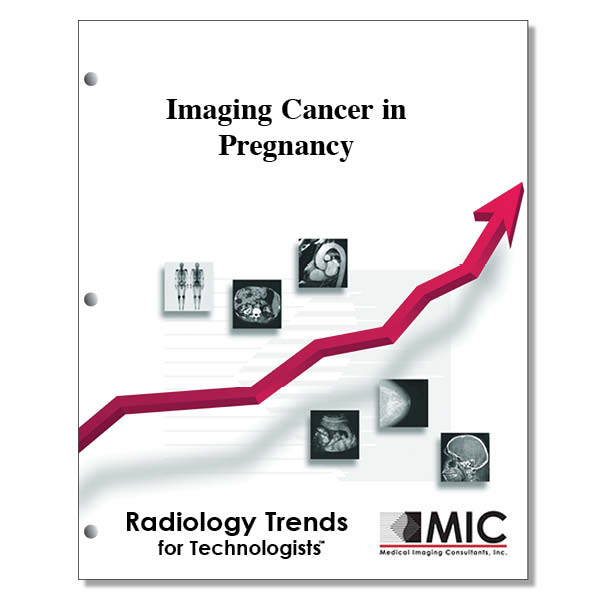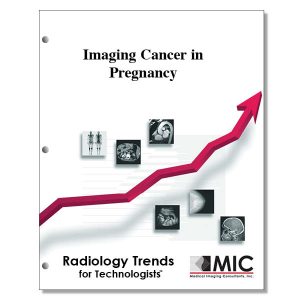

Imaging Cancer in Pregnancy
A review of diagnostic imaging in pregnancy with emphasis on safe imaging triage, minimization of risk to mother and fetus while optimizing outcomes, cancer-specific imaging, and treatment options.
Course ID: Q00791 Category: Radiology Trends for Technologists Modalities: CT, Mammography, MRI, Nuclear Medicine, PET, Radiation Therapy, RRA, Sonography2.75 |
Satisfaction Guarantee |
$29.00
- Targeted CE
- Outline
- Objectives
Targeted CE per ARRT’s Discipline, Category, and Subcategory classification:
[Note: Discipline-specific Targeted CE credits may be less than the total Category A credits approved for this course.]
Computed Tomography: 0.75
Procedures: 0.75
Head, Spine, and Musculoskeletal: 0.25
Neck and Chest: 0.25
Abdomen and Pelvis: 0.25
Magnetic Resonance Imaging: 0.75
Procedures: 0.75
Neurological: 0.25
Body: 0.25
Musculoskeletal: 0.25
Nuclear Medicine Technology: 0.75
Procedures: 0.75
Endocrine and Oncology Procedures: 0.75
Registered Radiologist Assistant: 1.50
Safety: 0.25
Patient Safety, Radiation Protection, and Equipment Operation: 0.25
Procedures: 1.25
Abdominal Section: 1.25
Sonography: 0.75
Procedures: 0.75
Abdomen: 0.25
Gynecology: 0.25
Superficial Structures and Other Sonographic Procedures: 0.25
Radiation Therapy: 2.75
Patient Care: 1.25
Patient and Medical Record Management: 1.25
Safety: 0.25
Radiation Physics and Radiobiology: 0.25
Procedures: 1.25
Treatment Sites and Tumors: 1.25
Outline
- Introduction
- Ultrasonography
- Magnetic Resonance Imaging
- Computed Tomography
- Nuclear Medicine
- Breast Cancer
- Hematologic Malignancy
- Cervical Cancer
- Endometrial Cancer
- Ovarian Cancer
- Vulvar and Vaginal Cancers
- Pancreatic Cancer
- Melanoma
- Thyroid Cancer
Objectives
Upon completion of this course, students will:
- define pregnancy associated cancer
- list the factors that aid in the detection of pregnancy-associated cancer
- state the basis for treatment selection for patients with pregnancy-associated cancer
- state the most common cause of death in women of childbearing age
- recall the incidence of pregnancy-related cancers
- list the most common pregnancy-associated cancers
- list the typical physiologic symptoms of pregnancy
- state the percent of pregnancy-related cancers that are diagnosed in the post-partum period
- choose the non-ionizing modalities that can be utilized for the detection of cancer in pregnant patients
- list the types of computed tomography exams that have negligible fetal exposure
- state the two types of radiation exposure
- provide the most vulnerable period of gestation for intellectual disability as it pertains to radiation exposure
- state the percent of exposed fetuses that will not develop a childhood cancer or leukemia
- explain counseling and informed consent procedures for imaging during pregnancy
- choose the most common imaging modality utilized for routine prenatal care
- list the MRI systems strengths that can be used for imaging in pregnancy
- state the American Academy of Pediatrics recommendation for fetal sound exposure
- provide the pregnancy drug category for Gadolinium
- choose what type of contrast material remains in the maternal gastrointestinal tract and is considered safe for administration during pregnancy
- explain how radiopharmaceuticals affect breast feeding
- list the key points of discussion with family members of pregnancy associated cancer patients
- know the frequency of pregnancy associated breast cancer
- state the reported incidence of BRCA-1 mutations with pregnancy-associated breast cancer
- list how patients with pregnancy-associated breast cancer present clinically
- state the percentage of biopsied palpable masses in pregnant and lactating patients that are benign
- list how treatment options for pregnancy-associated breast cancer are determined
- state the percent of hematologic malignancies associated with pregnancy-associated cancers
- state the most common hematologic malignancy in pregnant patients
- recall the number of cervical cancer cases in pregnant patients
- list the number of malignant ovarian masses per 100,000 patients
- choose the imaging modality of choice for sonographically indeterminate adnexal masses
- state the percentage of pregnancy-associated gastrointestinal cancers
- choose the most common site of colorectal cancer during pregnancy
- select the major risk factor for development of pancreatic adenocarcinoma in pregnancy
- describe thyroid cancers diagnosed in pregnancy
